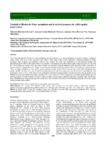Use este identificador para citar ou linkar para este item:
http://biblioteca.incaper.es.gov.br/digital/handle/item/727Registro completo de metadados
| Campo DC | Valor | Idioma |
|---|---|---|
| dc.contributor.author | SOBREIRA, F. M. | pt_BR |
| dc.contributor.author | OLIVEIRA, A. C. B. de. | pt_BR |
| dc.contributor.author | PEREIRA, A. A. | pt_BR |
| dc.contributor.author | SAKYAMA, N. S. | pt_BR |
| dc.contributor.other | Fabrício Moreira Sobreira, Incaper; Antonio Carlos Baião de Oliveira; Antonio Alves Pereira; Ney Sussumu Sakyiama. | pt_BR |
| dc.date.accessioned | 2015-03-30T19:26:13Z | - |
| dc.date.available | 2015-03-30T19:26:13Z | - |
| dc.date.created | 2015 | pt_BR |
| dc.date.issued | 2015-03-30 | pt_BR |
| dc.identifier.other | 6089 | pt_BR |
| dc.identifier.uri | http://biblioteca.incaper.es.gov.br/digital/handle/item/727 | - |
| dc.description | This work evaluated the Híbrido de Timor germplasm and the potential of its derived progenies as genetic resources to improve coffee quality, with focus on the specialty coffee market. Thirty eight Coffea arabica genotypes, comprising Híbrido de Timor genotypes, their progenies and traditional cultivars were studied. The study was conducted in a non-replicated design with intercalated checks where coffee cherry fruits were selectively handpicked and washed. Bean quality (shape and size) was assessed by a set of coffee test screens, while the sensory quality was measured using the attributes of the Specialty Coffee Association of America (SCAA) Cupping Protocols. Simple correlations and principal component analyses (PCA) were applied to analyze the data. There was high correlation for most of the sensory attributes, mainly between flavor and the final score (0.96). Regarding bean quality variables, the bean sieve sizes 19 and 18 correlated positively with the average sieve size (0.84 to 0.93) and negatively with the peaberry sieve (-0.55 to -0.69). The two first principal components illustrated genetic diversity for beans and cup quality. Some Híbrido de Timor and Catimor accessions, including UFV 454-43 and UFV 390-52, respectively, presented greater quality and may meet the interests of coffee breeders. For these, tasters described special nuances related to chocolaty, caramelly, fruity and flowery tastes. The Híbrido de Timor germplasm and its derivatives show potential to be used in coffee breeding programs which seek quality for the specialty coffee market. | pt_BR |
| dc.language | pt_BR | pt_BR |
| dc.publisher | In: Australia Journal of Crop Science, 9(4), p. 289-295, 2015. | pt_BR |
| dc.subject | Specialty coffee | pt_BR |
| dc.subject | Bourbon | pt_BR |
| dc.subject | Flavor | pt_BR |
| dc.subject | Cup quality | pt_BR |
| dc.subject | Genetic resources | pt_BR |
| dc.title | Potential of Híbrido de Timor germplasm and its derived progenies for coffee quality improvement. | pt_BR |
| dc.type | -- | pt_BR |
| dc.ainfo.id | 6042 | pt_BR |
| dc.ainfo.lastupdate | 2015-03-30 | pt_BR |
| dc.ainfo.depositante | Merielem Frasson | pt_BR |
| Aparece nas coleções: | Memória Técnica do Incaper  | |
Arquivos associados a este item:
| Arquivo | Descrição | Tamanho | Formato | |
|---|---|---|---|---|
| soberia-9-4-2015-289-295.pdf | 485,14 kB | Adobe PDF |  Visualizar/Abrir |
Os itens no repositório estão protegidos por copyright, com todos os direitos reservados, salvo quando é indicado o contrário.
